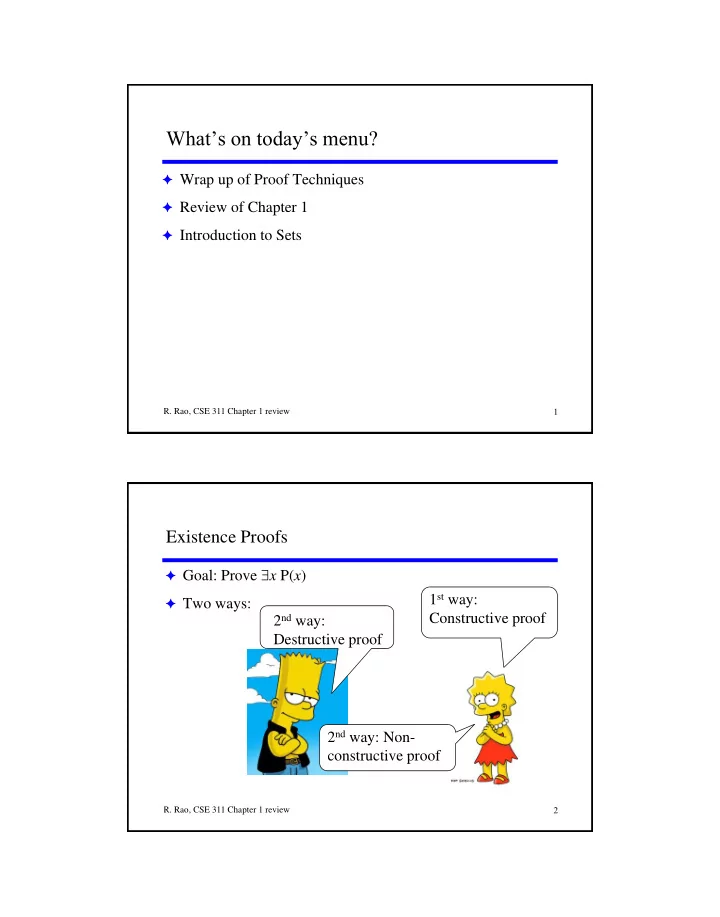

What’s on today’s menu? F Wrap up of Proof Techniques F Review of Chapter 1 F Introduction to Sets R. Rao, CSE 311 Chapter 1 review 1 Existence Proofs F Goal: Prove x P( x ) 1 st way: F Two ways: 2 nd way: Constructive proof Destructive proof 2 nd way: Non- constructive proof R. Rao, CSE 311 Chapter 1 review 2
Constructive Existence Proof F Goal: Prove x P( x ) Constructive proof method : Construct an a such that P( a ) true Example: Prove that there exist nonzero integers x , y , z such that x 2 + y 2 = z 2 . Proof: Let x = 3, y = 4, z = 5. (Actually, infinitely many solutions) Homework: Prove this for x n + y n = z n for all integers n > 2. Scratch that. This is Fermat’s last theorem: Took 358 years to prove! See > 100-pages proof by Wiles (1995). R. Rao, CSE 311 Chapter 1 review 3 Non-Constructive Existence Proof F Goal: Prove x P( x ) Non-constructive proof method : Prove indirectly, e.g., via a contradiction. Example: A real no. r is rational iff integers p,q s.t. r = p/q. A real no. is irrational iff it is not rational. Prove that irrational x,y s.t. x y is rational. 2 Pf. We know is irrational (see text). Consider . 2 2 2 Two possibilities: (a) is rational. Then, choose x = y = . 2 2 (b) is irrational. Choose x = and y = . Then, x y = 2 is 2 2 2 2 2 rational. Either way, we have shown x,y s.t. x y is rational. (Doesn’t say which is true!) R. Rao, CSE 311 Chapter 1 review 4
Review of Chapter 1 F Propositional Logic Propositions, logical operators , , , , , , truth tables for operators, precedence of logical operators Compound propositions, truth tables for compound propositions Converse, contrapositive, and inverse of p q Converting from/to English and propositional logic F Propositional Equivalences Tautology versus contradiction Logical equivalence p q Tables of logical equivalences (tables 6, 7, 8 in text) De Morgan’s laws Showing two compound propositions are logically equivalent via (a) truth table method and (b) via equivalences in tables 6, 7, 8. R. Rao, CSE 311 Chapter 1 review 5 Predicate Logic F Predicates and Quantifiers Predicates, variables, and domain of each variable Universal and existential quantifiers and (uniqueness !) Truth value of a quantifier statement Restricting domain of a quantifier, precedence over other operators, and binding variable to a quantifier Logical equivalence of two quantified statements Negation and De Morgan’s laws for quantifiers Translating to/from English F Nested Quantifiers Quantifiers as loops Order of quantifiers matters! Translating to/from English, negating nested quantifiers R. Rao, CSE 311 Chapter 1 review 6
Rules of Inference F Argument, Premises, Conclusion, Argument form Valid argument and valid argument form (show it is a tautology). F Rule of inference = valid argument form. Table 1 (p. 66). Modus ponens: [p (p q)] q Modus tollens: [(p q) q] p Hypothetical Syllogism: [(p q) (q r)] (p r) Disjunctive Syllogism: : [(p q) p] q Addition, Simplification, Conjunction Resolution: [(p q) ( p r)] (q r) F Using rules of inference to prove statements from premises F Rules of inference for quantified statements: instantiation and generalization R. Rao, CSE 311 Chapter 1 review 7 Proofs and Proof Methods F Direct proof of p q: Assume p is true; show q is true. Example in class: If n is an even integer, then n 2 is even. F Proof of p q by contraposition: Assume q and show p. Example in class: If n 2 is even for integer n, then n is even. F Vacuous and Trivial Proofs of p q F Proof by contradiction of a statement p: Assume p is not true and show this leads to a contradiction (r r). Example in class: Pigeonhole principle F Proofs of equivalence for p q: Show p q and q p F Proof by cases and Existence proofs R. Rao, CSE 311 Chapter 1 review 8
Enuff review, let’s move on to sets!! John McEnroe R. Rao, CSE 311 Chapter 1 review 9
Recommend
More recommend